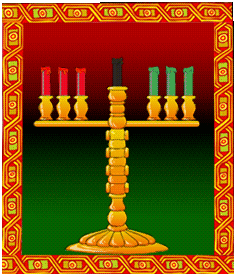![]()
KWANZAA
![]()
 Kwanzaa is a unique African American celebration with focus on the traditional
African values of family, community responsibility, commerce, and
self-improvement. Kwanzaa is neither political nor religious and despite some
misconceptions, is not a substitute for Christmas. It is simply a time of
reaffirming African-American people, their ancestors and culture. Kwanzaa, which
means "first fruits of the harvest" in the African language Kiswahili,
has gained tremendous acceptance. Since its founding in 1966 by Dr. Maulana
Karenga, Kwanzaa has come to be observed by more than18 million people
worldwide, as reported by the New York Times. When establishing Kwanzaa in 1966,
Dr. Karenga included an additional "a" to the end of the spelling to
reflect the difference between the African American celebration (kwanzaa) and
the Motherland spelling (kwanza).
Kwanzaa is a unique African American celebration with focus on the traditional
African values of family, community responsibility, commerce, and
self-improvement. Kwanzaa is neither political nor religious and despite some
misconceptions, is not a substitute for Christmas. It is simply a time of
reaffirming African-American people, their ancestors and culture. Kwanzaa, which
means "first fruits of the harvest" in the African language Kiswahili,
has gained tremendous acceptance. Since its founding in 1966 by Dr. Maulana
Karenga, Kwanzaa has come to be observed by more than18 million people
worldwide, as reported by the New York Times. When establishing Kwanzaa in 1966,
Dr. Karenga included an additional "a" to the end of the spelling to
reflect the difference between the African American celebration (kwanzaa) and
the Motherland spelling (kwanza).
Kwanzaa is based on the Nguzo Saba (seven guiding principles), one for each day of the observance, and is celebrated from December 26th to January 1st.
![]()
As it is always better to get an early start, we suggest that you begin the first week in December by making a check list for the following items: A Kinara (candle holder); Mkeka (placemat preferably made of straw); Mazao (crops, i.e., fruits and vegetables); Vibunzi (ears of corn to reflect the number of children in the household); Kikombe cha umoja (communal unity cup); Mishumaa saba (seven candles, one black, three red, and three green); and Zawadi (gifts that are enriching).
It is important that the Kinara not be confused with the menorah. The Kinara holds seven candles to reflect the seven principles which are the foundation of Kwanzaa. If you don't have a Kinara and don't know where to get one, it is suggested that you use "kuumba" (creativity) and make one. A 2x4 or a piece of driftwood will do just fine, and screw-in candle holders can be purchased in most hardware stores. The Mkeka (place mat) shouldn't present a problem. While straw is suggested because it is traditional, cloth makes an adequate substitute. If cloth is used, one with an African print is preferred. The other symbols are easy to come by and warrant no further discussion other than to caution against placing the Mazao (crops) in a cornucopia which is Western. A plain straw basket or a bowl will do just fine. One last note, even households without any children should place an ear of corn on the place mat to symbolize the African concept of social parenthood. All seven symbols are creatively placed on top of the place mat, i.e., the symbols should be attractively arranged as they form the Kwanzaa centerpiece.
![]()
DECORATING THE HOME
The Kinara along with the other symbols of Kwanzaa should dominate the room, which should be given an African motif. This is easily achieved and shouldn't result in too much expense. The colors of Kwanzaa are black, red and green. This should be kept in mind when decorating the home. Black, red and green streamers, balloons, cloth, flowers, and African prints can be hung tastefully around the room. Original art and sculpture may be displayed as well.
![]()
GIFTS
Kuumba (creativity) is greatly encouraged. Not only is Kuumba one of the seven principles, it also brings a sense of personal satisfaction and puts one squarely into the spirit of Kwanzaa. Therefore, those symbols that can be made, should be made. The giving of gifts during Kwanzaa should be affordable and of an educational or artistic nature. Gifts are usually exchanged between parents and children and traditionally given on January 1st, the last day of Kwanzaa. However, gift giving during Kwanzaa may occur at any time.
![]()
THE KWANZAA FEAST OR KARAMU
The Kwanzaa Karumu is traditionally held on December 31st (participants
celebrating New Year's Eve, should plan their Karamu early in the evening).
It is a very special event as it is the one Kwanzaa event that brings us closer
to our African roots. The Karamu is a communal and cooperative effort.
Ceremonies and cultural expressions are highly encouraged. It is important
to decorate the place where the Karamu will be held, (e.g., home, community
center, church) in an African motif that utilizes black, red, and green color
scheme. A large Kwanzaa setting should dominate the room where the karamu
will take place. A large Mkeka should be placed in the center of the floor
where the food should be placed creatively and made accessible to all for
self-service. Prior to and during the feast, an informative and
entertaining program should be presented. Traditionally, the program
involved welcoming, remembering, reassessment, recommitment and rejoicing,
concluded by a farewell statement and a call for greater unity.
Copyright ©Emotions Greeting Cards a division of VH Productions 2000-2002